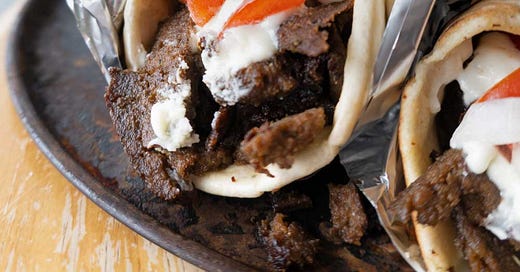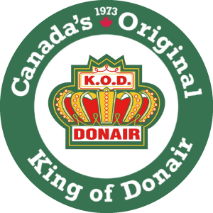Over the twenty years of traveling to Nova Scotia the word "Donair" seemed to seep in everywhere from Halifax to Cape Breton; I had the impression it was some sort of ready-made sandwich. But Donair pizza became a thing and by 2015 I was seeing Donair-everything: egg rolls, eggs Benedict, burgers, samosas, even poutine. In Quebec a few years prior, I discovered poutine --basically a pile of fries topped with cheese curds and brown gravy--a savory mess that the entire province seemed as mad for as Nova Scotia was for Donair. I vividly remember sitting in a hotel lobby in Quebec that had a TV monitor on which a McDonald’s ad was featuring poutine. Likewise, in Nova Scotia there are ads for Donair and I overheard people in public talking about it everywhere I went.
Once I asked Carole, who had lived in Cape Breton every summer for a couple of decades: "What the heck is a Donair”? As a cook myself, one of the things I love about her is that she is an adventurous eater. Likewise Duncan; no one showed enthusiasm for food in quite the same way as he: you knew you were on solid ground when, after his first bite of your dish he declared, in his gravelly, emphatic way “Man , that’s good!”1 So I was a bit surprised when Carole wrinkled her cute little Minnesotan nose and revealed that it was some indigenous Canadian meat that she found to be kind of gross, especially the sauce. At that point I dropped my inquiry because I trust her and frankly I was just too into the local seafood and Duncan’s garden to be bothered. And besides, Donair always seemed to come as a prepared food, which is something I rarely get involved with.
On this trip I had some time, partly as a function of being solo, and took the opportunity to fulfill my inability to let my knowledge void of this indigenous food continue to occupy a blank page in my journal. In the second month of this summer Donair really did seem bigger than ever so I finally decided to check it out. Not by tasting, mind you, (because I still trust Carole) but by arm's length research. What followed was a rabbit hole that is also a story about history, human nature, cultural appropriation, and about a rise to fame; but really it is a story about a food.
Make it at home if you D(on)air
First, I ascertained that Donair has two components: 1) the meat: spiced ground beef, shaped to accommodate spit roasting, then shaved and also seared; and, 2) the sauce: a sweet mixture of evaporated milk with vinegar, garlic powder and sugar.2
It is no small coincidence that I embarked on this research on a day that the Turkish military launched an attempted coup de etat. According to Wikipedia it turns out that Donair is not of Nova Scotian genesis as it is a variation of Doner, a Turkish word for rotating roasted meat; think kebab or in the Greek version, gyro. Because this dish has executed a culinary coup in Nova Scotia that is apparently spreading across Canada, I see this as a sign that I am on to something.
Although derived from the traditional Middle Eastern dish, Doner has been reinterpreted in just about every country in the world, just like here in Canada. Hence, the story of cultural appropriation.
Donair was likely invented in Halifax by a Greek emigre who was just so blown away by the fact that Canadians did not like his rotated roasted meat sandwich, he took it as a challenge to create a version they would lap up; and he called it Donair (which really is a Canadian riff on the Turkish word). Not only do they like it, after a slow-cooked, four-decade rise to the most coveted category of Maritime sustenance, it was finally named the official food of Halifax in 2015 (hence, the rise to fame). Here is the logo:
As with all famous things, it seems, there is controversy as to the origination of the dish. Although the Donair History website attributes the invention of the gyro type dish to a fellow in Berlin in 1971, there is a founder rivalry in Canada between the aforementioned Greek fellow and a guy known as the “King of Donair” who began his chain of Donair pizza restaurants in the 1970's, even as the Berlin thing was getting off the ground. (So there you have the history and human nature angles, coming with the concomitant and requisite confusion that accompanies much historical inquiry as documentation is rarely painstakingly recorded.)
In a 2012 Toronto Globe and Mail special report, Simon Thibault drilled down into the background of this colloquial dish that is a star of the after-hours Halifax bar scene. Simon says that the Berlin thing was in the 1950's and resulted in the kebab, followed by the Greek gyro. So Turkey is only tangentially related to the dish. Business oddities:
Then in the late 1960's the Greek, now Canadian, Kamoulakos brothers, Pete and John, put a Maritime spin on the sauce and made a ground beef substitution for lamb. Yogurt and ovines were just unknowns in these parts and consequently Canadians just did not go for the flavors; so one or the other of these guys came up with the ground beef seasoning and molding process and changed the sauce from a yogurt base to evaporated milk to appease the Northern palate.
It worked.
Subsequently, Pete passed away and now John, whom Pete's son says was just the business side of the operation, of course tries to take the credit for the recipe, resulting in the predictable family division. As a result, walls are being erected and we will likely never be able to ascertain the truth as the dead guy’s son is hardly an unbiased witness. Not only does this muddy the waters on the history, it also just adds to the lore, which very often is what makes this kind of thing take off in the first place.
Also, as we know, the economy drives a lot of evolution. Because there is so little work in Nova Scotia outside of Halifax and especially on Cape Breton, many, many people are going "away" to work and a great number of them commute. I know of a guy who works in a diamond mine in northern Alberta for 3 weeks and then comes home to Judique for 3 weeks. Many CB-ers work at Fort MacMurray which was in the news the summer of 2016 because the entire town nearly burned down in horrific spring forest fires, throwing a lot of workers out of the area. In addition, lots of the younger set just flat move out west to British Columbia and Alberta where there is more work in general. They are spreading the Donair craze with them.
Whatever you do, I strongly advise that when in Nova Scotia, keep this information to yourself. The last time I was there I was party to a casual conversation with perfect strangers in which the topic of Donair arose. I mentioned that it was not really from Canada in that the food from which it is derived was actually invented in Berlin. My fellow conversant transformed into a enemy combatant on the spot; it was as if I had said her daughter was ugly. She was having none of it; Donair was Nova Scotian and therefore it belonged to her. I swiftly changed the subject.
I suppose I will eventually try Donair, but after all of this I think I want to wait until my next visit to Halifax as I would think it best to get as close to the source as possible; not so much because I am an authenticity snob3, but more because I can't envision eating it as a prepared food item from a grocery which is the only option in Judique and its environs (unless I make it at home which is most unlikely, unless, of course, I go on line and order a jar of Donair spice—it kept popping up in my Facebook feed for weeks that summer), which is taking the whole thing to a level that probably Pete would never have even dreamed about.
Do you suppose that makes John, the business-side (read: marketing) brother the winner?
This expression has become a cliché in our family.
It turns out there is a recipe for it on the American website Allrecipes:
For a fun read on "authenticity" check out this column from Tasting Table.





